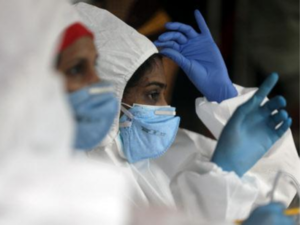 Reuters
ReutersTheir numbers have been dwindling over the years — from 398 in the 2001 Census to 229 in 2011, with the 2004 tsunami striking the island in between. Now, the novel coronavirus, which has killed over 7.5 lakh people across the world, has reached the doorstep of the Shompens. Five passengers of MV Campbell Bay, a ship that docked at the island on July 29, turned symptomatic and tested positive for Covid-19. The ship was coming from Port Blair, the capital of the Union territory of Andaman and Nicobar Islands where Nicobar is one of the three districts.
“We have stopped all inbound ships into the district and are doubly sanitising rations such as rice and salt meant for the Shompen,” Kishore Kshirsagar Lakshman, deputy commissioner of Nicobar district, told ET Magazine over the phone, adding that the administration has been readying 12 Covid Care Centres in the district, including five in the Great Nicobar island, with a total capacity of about 180 beds. The district, comprising 22 islands, out of which 10 are inhabited, has so far had 12 positive cases but none of them has been from the Shompen tribe as yet. In the entire Union territory, more than 2,000 people have tested positive, with 22 deaths.
With the deadly virus reaching sensitive tribal belts — from Nicobar to Bastar to the Northeast — infecting even PVTGs, the question is whether the local administrations in these far-flung districts are equipped in terms of medical infrastructure and testing facilities to stop a potential disaster. This has become more pertinent in the backdrop of the recent undeclared shift of the government from defeating the virus to finding ways to live with it.
Lok Sabha Elections#Elections With 
- All
- Uttar Pradesh
- Maharashtra
- Tamil Nadu
- West Bengal
- Bihar
- Karnataka
- Andhra Pradesh
- Telangana
- Kerala
- Madhya Pradesh
- Rajasthan
- Delhi
- Other States
The virus has already spread in Bastar’s Abujhmad, where the PVTG Abujh Maria lives. The administration of Narayanpur, the district in Chhattisgarh where most of the Abujh Marias reside, has confirmed that five persons belonging to the tribe have tested positive, with no fatalities so far.
Says district magistrate Abhijeet Singh: “Abujh Marias are comparatively less connected with the outside world and their villages are sparsely populated. However, five of them with travel history have tested positive out of the 265 coronavirus cases in my district. A 100-seater Covid Care Centre is operational here and, additionally, we are converting a hostel into a 600-bed centre.” A TrueNat machine to diagnose Covid-19 has also been installed and will be operational from Tuesday, Singh adds.

There are 75 PVTG spread across 19 states and Union territories. They include Asur and Birhor of Bihar and Jharkhand, Thoti of Andhra Pradesh and Telangana, Kadar of Kerala and Sahariya of Madhya Pradesh and Rajasthan. The PVTG classification has been made on the basis of the tribes’ “preagriculture level of technology”, stagnation or decline of population, low level of literacy and subsistence level of economy.
No official data is available on whether these vulnerable tribals have been infected by Covid even when the districts where they live are affected by the virus. “I can confirm this much: no one from Asur tribe has died of Covid,”says Shishir Kumar Sinha, district magistrate of Jharkhand's Gumla district, which has a sizeable Asur population. In Madhya Pradesh's Sheopur district, Giriraj Paliwal, a panchayat secretary of Ranipura, says the Sahariya tribals were initially wary of the virus, but now they are going out for work in agricultural fields as well as in construction sites. Sheopur has some large Sahariya clusters.
As on Friday, out of 736 districts in India, only four - Arunachal Pradesh's Kurung Kumey, Kra Daadi and Dibang Valley, as well as Lakshadweep - have been unaffected by the pandemic with zero positive cases so far. Incidentally, all are tribal districts though none of the tribes living in these districts comes under the PVTG classification. Yet, the topography of their habitats and the small population pose a challenge to the administration. In Dibang Valley district, for example, the population is only 8,004 (2011 census), comparable to a large housing society in a metro city. They belong to Idu Mishmi tribe. "In my district, any outsider is easily spotted. Locals often inform us about anyone coming in from the rest of the state," says deputy commissioner Minga Sherpa.
While geographical remoteness has helped a handful of districts in keeping the pandemic at bay, it has been a hurdle in setting up new healthcare facilities in others. In Nicobar district, for example, the administration has had to establish 12 Covid Care Centres for a small population of 36,842 (2011 census), since the islands are far flung from each other. Its Indira Point, also India's southernmost point, is 310 km from the district headquarters in Car Nicobar, while it is barely 140 km from Indonesia's Sumatra island.
Soumendra Mohan Patnaik, anthropologist and vice-chancellor of Utkal University, Odisha, says isolation of the indigenous community from the mainstream is not desirable, but any contact with outsiders needs to be handled in a sensitive manner. "In the case of tribal community, health must not be understood only as a bio-medical term," he says.
"Their notion of health or well being is embedded in the environment they live in. Any disease, displacement or an outside contact disrupts that equilibrium."
Download The Economic Times News App to get Daily Market Updates & Live Business News.
Subscribe to The Economic Times Prime and read the ET ePaper online.
Read More News on
Download The Economic Times News App to get Daily Market Updates & Live Business News.
Subscribe to The Economic Times Prime and read the ET ePaper online.













 Get Unlimited Access to The Economic Times
Get Unlimited Access to The Economic Times
